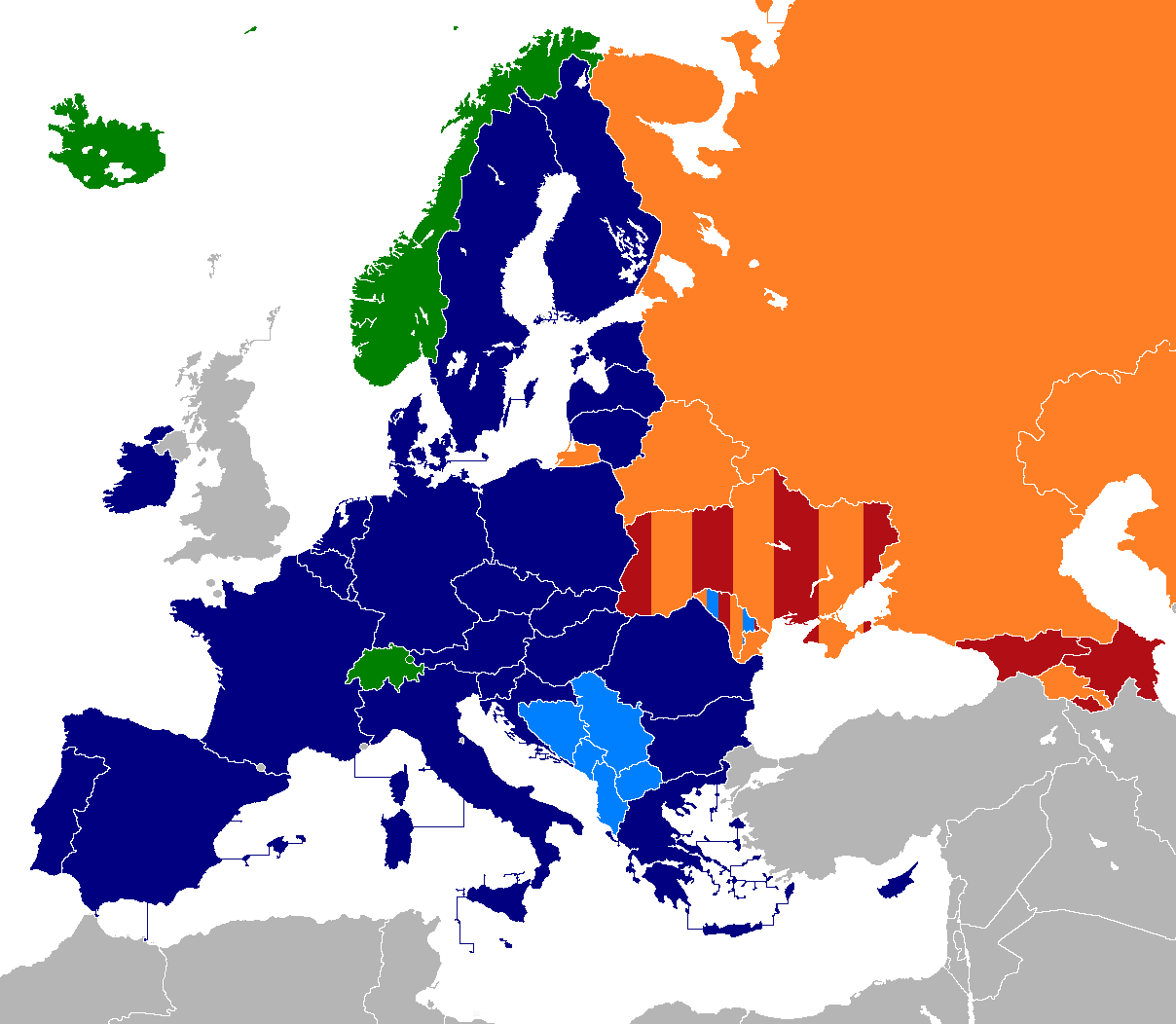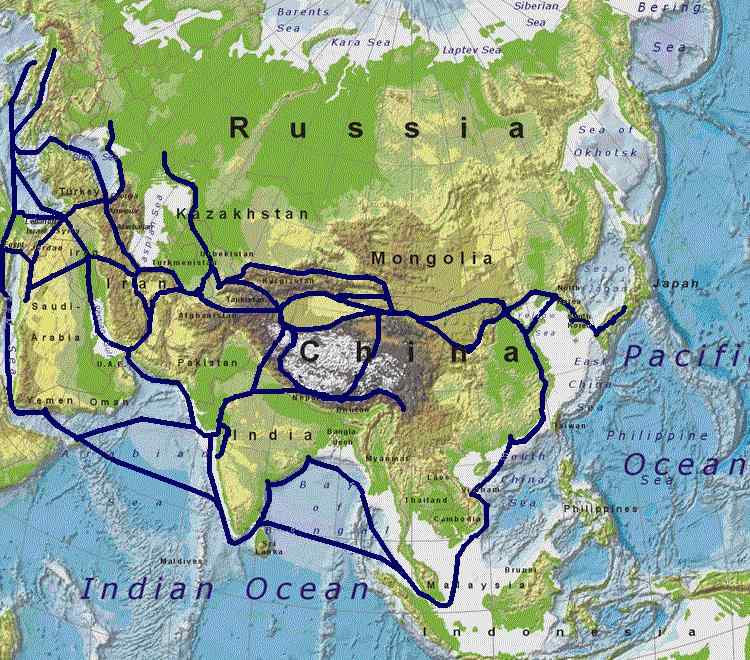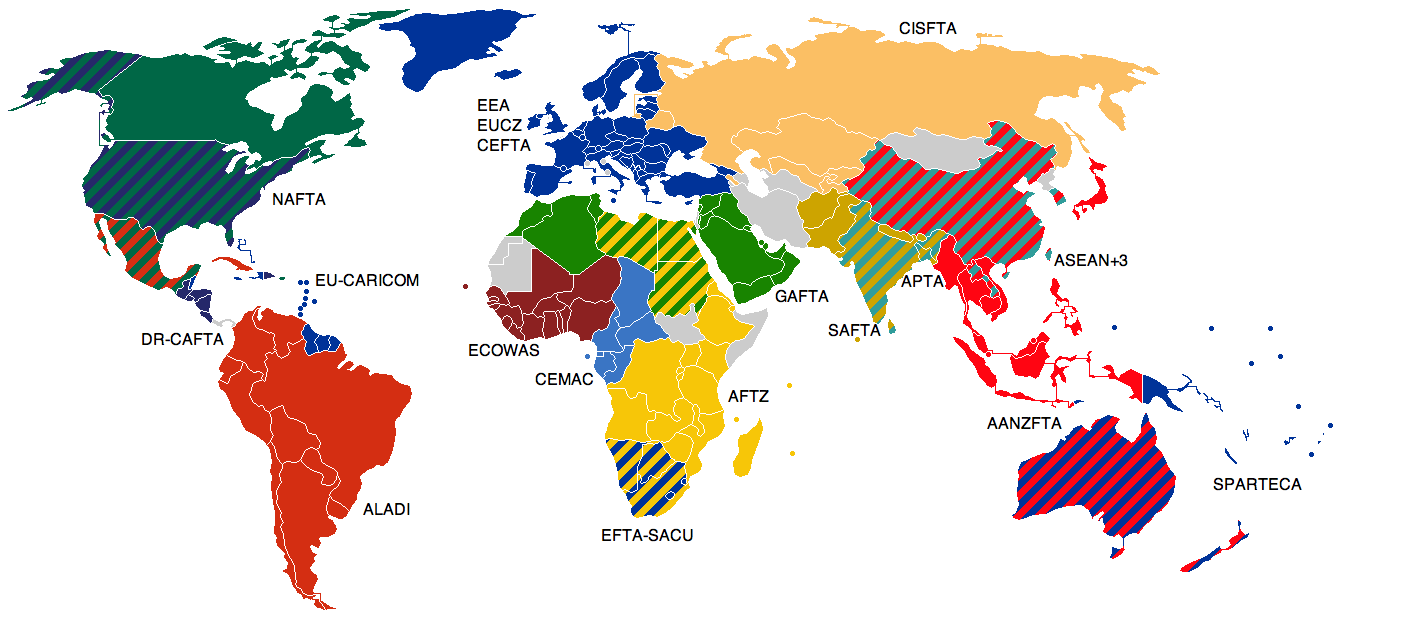|
CISFTA
Commonwealth of Independent States Free Trade Area (CISFTA) is a free-trade area among Russia, Ukraine, Belarus, Uzbekistan, Moldova, Armenia, Kyrgyzstan, Kazakhstan and Tajikistan. Five CISFTA participants, all except Ukraine, Uzbekistan, Moldova and Tajikistan, are members of the Eurasian Economic Union, comprising a single economic market, although Uzbekistan and Moldova are observers. History The Commonwealth of Independent States Free Trade Zone Agreement, proposed since the breakup of the Soviet Union in 1991, was signed on 18 October 2011 by Russia, Ukraine, Belarus, Kazakhstan, Kyrgyzstan, Tajikistan, Moldova and Armenia. The agreement replaces existing bilateral and multilateral free trade agreements among the countries. Initially, the treaty was only ratified by Russia, Belarus, and Ukraine, however by the end of 2012, Kazakhstan, Armenia, and Moldova had also completed ratification. In December 2013, Uzbekistan signed and then ratified the treaty, while the remainin ... [...More Info...] [...Related Items...] OR: [Wikipedia] [Google] [Baidu] |
Eurasian Economic Union
The Eurasian Economic Union (EAEU or EEU)EAEU is the acronym used on thorganisation's website However, many media outlets use the acronym EEU. is an economic union of some post-Soviet states located in Eurasia. The Treaty on the Eurasian Economic Union was signed on 29 May 2014 by the leaders of Belarus, Kazakhstan, and Russia, and came into force on 1 January 2015. Treaties aiming for Armenia's and Kyrgyzstan's accession to the Eurasian Economic Union were signed on 9 October and 23 December 2014, respectively. Armenia's accession treaty came into force on 2 January 2015. Kyrgyzstan's accession treaty came into effect on 6 August 2015. Kyrgyzstan participated in the EAEU from the day of its establishment as an acceding state. The Eurasian Economic Union has an integrated single market of 184 million people and a gross domestic product of over $1.9 trillion. The EAEU encourages the free movement of goods and services, and provides for common policies in the macroeconomic spher ... [...More Info...] [...Related Items...] OR: [Wikipedia] [Google] [Baidu] |
Eurasian Union
The Eurasian Economic Union (EAEU or EEU)EAEU is the acronym used on thorganisation's website However, many media outlets use the acronym EEU. is an economic union of some post-Soviet states located in Eurasia. The Treaty on the Eurasian Economic Union was signed on 29 May 2014 by the leaders of Belarus, Kazakhstan, and Russia, and came into force on 1 January 2015. Treaties aiming for Armenia's and Kyrgyzstan's accession to the Eurasian Economic Union were signed on 9 October and 23 December 2014, respectively. Armenia's accession treaty came into force on 2 January 2015. Kyrgyzstan's accession treaty came into effect on 6 August 2015. Kyrgyzstan participated in the EAEU from the day of its establishment as an acceding state. The Eurasian Economic Union has an integrated single market of 184 million people and a gross domestic product of over $1.9 trillion. The EAEU encourages the free movement of goods and services, and provides for common policies in the macroeconomic spher ... [...More Info...] [...Related Items...] OR: [Wikipedia] [Google] [Baidu] |
Free Trade Areas In Europe
At present, there are four multi-lateral free trade areas in Europe, and one former free trade area in recent history. Note that there are also a number of bilateral free trade agreements between states and between trade blocks; and that some states participate in more than one free trade area. EU The European Union (EU) has always operated as more than a free trade area with its predecessor, the European Economic Community (EEC) being founded as a customs union. The EU has free trade agreements to varying levels with most other European countries. ;EU Single Market The EU shares Internal market, its single market with three EFTA members via the European Economic Area agreement, and the remaining EFTA member—Switzerland—via bilateral agreements. ;EU Customs Union The European Union Customs Union is a customs union which consists of all the member states of the European Union and Turkey, San Marino, Monaco, Andorra and the UK territory of Akrotiri and Dhekelia which are o ... [...More Info...] [...Related Items...] OR: [Wikipedia] [Google] [Baidu] |
Trade Bloc
A trade bloc is a type of intergovernmental agreement, often part of a regional intergovernmental organization, where barriers to trade (tariffs and others) are reduced or eliminated among the participating states. Trade blocs can be stand-alone agreements between several states (such as the North American Free Trade Agreement) or part of a regional organization (such as the European Union). Depending on the level of economic integration, trade blocs can be classified as preferential trading areas, free-trade areas, customs unions, common markets, or economic and monetary unions. Use Historic trading blocs include the Hanseatic League, a Northern European economic alliance between the 12th and 17th centuries, and the German Customs Union, formed on the basis of the German Confederation and subsequently the German Empire from 1871. Surges of trade bloc formation occurred in the 1960s and 1970s, as well as in the 1990s after the collapse of Communism. By 1997, more than 50% of a ... [...More Info...] [...Related Items...] OR: [Wikipedia] [Google] [Baidu] |
Commonwealth Of Independent States
The Commonwealth of Independent States (CIS) is a regional intergovernmental organization in Eurasia. It was formed following the dissolution of the Soviet Union in 1991. It covers an area of and has an estimated population of 239,796,010. The CIS encourages cooperation in economic, political and military affairs and has certain powers relating to the coordination of trade, finance, lawmaking, and security. It has also promoted cooperation on cross-border crime prevention. As the Soviet Union disintegrated, Belarus, Russia and Ukraine signed the Belovezh Accords on 8 December 1991, declaring that the Union had effectively ceased to exist and proclaimed the CIS in its place. On 21 December, the Alma-Ata Protocol was signed. The Baltic states (Estonia, Latvia and Lithuania), which regard their membership in the Soviet Union as an illegal occupation, chose not to participate. Georgia withdrew its membership in 2008 following the Russo-Georgian War. Ukraine formally ended its ... [...More Info...] [...Related Items...] OR: [Wikipedia] [Google] [Baidu] |
Post-Soviet States
The post-Soviet states, also known as the former Soviet Union (FSU), the former Soviet Republics and in Russia as the near abroad (russian: links=no, ближнее зарубежье, blizhneye zarubezhye), are the 15 sovereign states that were union republics of the Soviet Union, which emerged and re-emerged from the Soviet Union following its dissolution in 1991. Russia is the primary ''de facto'' internationally recognized successor state to the Soviet Union after the Cold War; while Ukraine has, by law, proclaimed that it is a state-successor of both the Ukrainian SSR and the Soviet Union which remained under dispute over formerly Soviet-owned properties. The three Baltic states – Estonia, Latvia, and Lithuania – were the first to declare their independence from the USSR, between March and May 1990, claiming continuity from the original states that existed prior to their annexation by the Soviet Union in 1940. The remaining 12 republics all subsequently seceded, ... [...More Info...] [...Related Items...] OR: [Wikipedia] [Google] [Baidu] |
Rules Of Origin
Rules of origin are the rules to attribute a country of origin to a product in order to determine its "economic nationality". The need to establish rules of origin stems from the fact that the implementation of trade policy measures, such as tariffs, quotas, trade remedies, in various cases, depends on the country of origin of the product at hand. Rules of origin have become a challenging topic in international trade, not only because they constitute a highly technical area of rule-making, but also because their designation and application have not been harmonized across the world. The lack of harmony is even more remarkable in the era of regionalism, when more and more free trade agreements (FTAs) are concluded, creating the spaghetti bowl effect. Definition of rules of origin The most comprehensive definition for rules of origin is found in the International Convention on the Simplification and Harmonization of Customs procedures (Kyoto Convention), which entered into forc ... [...More Info...] [...Related Items...] OR: [Wikipedia] [Google] [Baidu] |
Market Access
In international trade, market access is a company's ability to enter a foreign market by selling its goods and services in another country. Market access is not the same as free trade, because market access is normally subject to conditions or requirements (such as tariffs or quotas), whereas under ideal free trade conditions goods and services can circulate across borders without any barriers to trade. Expanding market access is therefore often a more achievable goal of trade negotiations than achieving free trade. Market access concessions and limitations to market access differ greatly between trade in goods and trade in services. While market access for goods mainly involves measures at the border such as customs duties or quantitative restrictions, market access for services relates more to the application of domestic regulation behind the border. Moreover, in a world of proliferating regionalism, preferential market access for goods and services also have distinctive charact ... [...More Info...] [...Related Items...] OR: [Wikipedia] [Google] [Baidu] |
Free-trade Area
A free-trade area is the region encompassing a trade bloc whose member countries have signed a free trade agreement (FTA). Such agreements involve cooperation between at least two countries to reduce trade barriers, import quotas and tariffs, and to increase trade of goods and services with each other. If natural persons are also free to move between the countries, in addition to a free-trade agreement, it would also be considered an open border. It can be considered the second stage of economic integration. Customs unions are a special type of free-trade area. All such areas have internal arrangements which parties conclude in order to liberalize and facilitate trade among themselves. The crucial difference between customs unions and free-trade areas is their approach to third parties. While a customs union requires all parties to establish and maintain identical external tariffs with regard to trade with non-parties, parties to a free-trade area are not subject to this requiremen ... [...More Info...] [...Related Items...] OR: [Wikipedia] [Google] [Baidu] |
Tariff
A tariff is a tax imposed by the government of a country or by a supranational union on imports or exports of goods. Besides being a source of revenue for the government, import duties can also be a form of regulation of foreign trade and policy that taxes foreign products to encourage or safeguard domestic industry. ''Protective tariffs'' are among the most widely used instruments of protectionism, along with import quotas and export quotas and other non-tariff barriers to trade. Tariffs can be fixed (a constant sum per unit of imported goods or a percentage of the price) or variable (the amount varies according to the price). Taxing imports means people are less likely to buy them as they become more expensive. The intention is that they buy local products instead, boosting their country's economy. Tariffs therefore provide an incentive to develop production and replace imports with domestic products. Tariffs are meant to reduce pressure from foreign competition and reduce th ... [...More Info...] [...Related Items...] OR: [Wikipedia] [Google] [Baidu] |
Treaties Concluded In 2011
A treaty is a formal, legally binding written agreement between actors in international law. It is usually made by and between sovereign states, but can include international organizations, individuals, business entities, and other legal persons. A treaty may also be known as an international agreement, protocol, covenant, convention, pact, or exchange of letters, among other terms. However, only documents that are legally binding on the parties are considered treaties under international law. Treaties vary on the basis of obligations (the extent to which states are bound to the rules), precision (the extent to which the rules are unambiguous), and delegation (the extent to which third parties have authority to interpret, apply and make rules). Treaties are among the earliest manifestations of international relations, with the first known example being a border agreement between the Sumerian city-states of Lagash and Umma around 3100 BC. International agreements were used in so ... [...More Info...] [...Related Items...] OR: [Wikipedia] [Google] [Baidu] |
Treaties Entered Into Force In 2012
A treaty is a formal, legally binding written agreement between actors in international law. It is usually made by and between sovereign states, but can include international organizations, individuals, business entities, and other legal persons. A treaty may also be known as an international agreement, protocol, covenant, convention, pact, or exchange of letters, among other terms. However, only documents that are legally binding on the parties are considered treaties under international law. Treaties vary on the basis of obligations (the extent to which states are bound to the rules), precision (the extent to which the rules are unambiguous), and delegation (the extent to which third parties have authority to interpret, apply and make rules). Treaties are among the earliest manifestations of international relations, with the first known example being a border agreement between the Sumerian city-states of Lagash and Umma around 3100 BC. International agreements were used in so ... [...More Info...] [...Related Items...] OR: [Wikipedia] [Google] [Baidu] |







.png)

